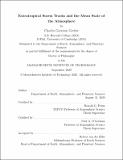| dc.contributor.advisor | Ronald G. Prinn and Paul A. O'Gorman. | en_US |
| dc.contributor.author | Gertler, Charles Garrison. | en_US |
| dc.contributor.other | Massachusetts Institute of Technology. Department of Earth, Atmospheric, and Planetary Sciences. | en_US |
| dc.date.accessioned | 2021-01-05T23:15:54Z | |
| dc.date.available | 2021-01-05T23:15:54Z | |
| dc.date.copyright | 2020 | en_US |
| dc.date.issued | 2020 | en_US |
| dc.identifier.uri | https://hdl.handle.net/1721.1/129058 | |
| dc.description | Thesis: Ph. D., Massachusetts Institute of Technology, Department of Earth, Atmospheric, and Planetary Sciences, 2020 | en_US |
| dc.description | Cataloged from student-submitted PDF of thesis. | en_US |
| dc.description | Includes bibliographical references (pages 127-135). | en_US |
| dc.description.abstract | The exact impacts of changes in the mean state of the atmosphere on the high-frequency phenomena that form the extratropical atmospheric circulation are uncertain. The extratropical storm tracks, regions of frequent extratropical cyclones, dominate weather in the extratropics, affecting the lives and livelihoods of billions of people. The results presented in this thesis connect changes in the mean state of the atmosphere to changes in the extratropical storm tracks. The Northern Hemisphere summer extratropical storm track has weakened in observations over the satellite era, while evidence indicates convective precipitation in the extratropics has concurrently increased. Using the concept of mean available potential energy (MAPE) partitioned into nonconvective and convective components, the second chapter of this thesis demonstrates that the changes in storm track strength and convection are consistent with changes in the temperature and humidity structure of the atmosphere. | en_US |
| dc.description.abstract | Further, experiments with idealized atmospheres indicate how characteristic changes in surface temperatures over this period lead to diverging changes in the energy available to extratropical cyclones and their associated convection. In the third chapter of this thesis, the storm track strength is examined in solar geoengineering scenarios using results from climate models. The Northern Hemisphere extratropical storm track weakens in response to increased CO₂ by similar magnitudes regardless of whether solar geoengineering is used. In the Southern Hemisphere, the storm track strengthens in global warming scenarios, but weakens with solar geoengineering. Storm track intensity changes are shown to be consistent with changes in the structure of temperature and humidity using MAPE. In the fourth chapter of this thesis, a new method to calculate MAPE is introduced and used to perform the first exact MAPE calculations in a three-dimensional domain. | en_US |
| dc.description.abstract | Further, an eddy-size restriction on the MAPE calculation is developed and introduced, which provides a measure of available energy that could be accessed locally by an extratropical cyclone. This approach is also used to identify the thermodynamic potential for ascent on the eddy lengthscale, which is shown to relate strongly to the frequency of warm conveyor belts (WCBs), dynamic components of extratropical cyclones with large impacts on weather. | en_US |
| dc.description.statementofresponsibility | by Charles Garrison Gertler. | en_US |
| dc.format.extent | 135 pages | en_US |
| dc.language.iso | eng | en_US |
| dc.publisher | Massachusetts Institute of Technology | en_US |
| dc.rights | MIT theses may be protected by copyright. Please reuse MIT thesis content according to the MIT Libraries Permissions Policy, which is available through the URL provided. | en_US |
| dc.rights.uri | http://dspace.mit.edu/handle/1721.1/7582 | en_US |
| dc.subject | Earth, Atmospheric, and Planetary Sciences. | en_US |
| dc.title | Extratropical storm tracks and the mean state of the atmosphere | en_US |
| dc.type | Thesis | en_US |
| dc.description.degree | Ph. D. | en_US |
| dc.contributor.department | Massachusetts Institute of Technology. Department of Earth, Atmospheric, and Planetary Sciences | en_US |
| dc.identifier.oclc | 1227037025 | en_US |
| dc.description.collection | Ph.D. Massachusetts Institute of Technology, Department of Earth, Atmospheric, and Planetary Sciences | en_US |
| dspace.imported | 2021-01-05T23:15:53Z | en_US |
| mit.thesis.degree | Doctoral | en_US |
| mit.thesis.department | EAPS | en_US |
